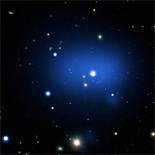
Cluster JKCS041 (Chandra)
Astronomy 358 - Spring 2010
GALAXIES AND THE UNIVERSE
TTh 2:00-3:30 · RLM 15.316B · Unique No. 49065
Professor
RLM 15.224 · (512) 471-1402 · email
Drop Dates. You may drop a course without academic penalty until February 15. You can then drop courses until March 29 with a Q or F, depending on your performance in class up to that time. March 29 is also the last day to change to or from the credit/no credit basis. After March 29, you may drop the course or withdraw from the University only for urgent and substantiated, nonacademic reasons. Please consult the University's published calendar (http://www.utexas.edu/registrar) to verify these dates and for further information.
About the Instructor. Professor Shields was born in Los Angeles, California and grew up in Nebraska and Kansas. He earned a B.S. in Physics from Stanford University in 1968 and a Ph.D. in Astronomy at Caltech in 1973. Following a postdoctoral fellowship at Harvard, he joined the UT faculty in 1974. He now holds the title of The Jane and Roland Blumberg Centennial Professor in Astronomy, and served as Chairman of the Department of Astronomy from 1990 to 1994. He has taught both graduate and undergraduate courses throughout his career at UT. His research interests include studies of ionized nebulae in galaxies and the nature of quasars and their central black holes. He has published numerous research papers and popular articles. Prof. Shields is currently serving as Chairman of the Undergraduate Studies Committee for the Department of Astronomy.
Background needed. AST 358 is one of several upper division courses required for Astronomy majors. The level of the course is aimed at giving them a good foundation for success in graduate school. The prerequisite for this course is Physics 316 "Electricity and Magnetism". There is no formal Astronomy course prerequisite for AST 358, but many students will have had AST 307 "Introductory Astronomy" or AST 352K "Stellar Astronomy". In order to be competitive in AST 358, students who have had no previous course in astronomy will need to study some basic background material by the second week of the semester. Reading resources will be made available, and students will be asked to work a set of homework problems designed to acquire and demonstrate knowledge of the essential background topics. This will allow us to move quickly into the main subject material of the course. Important topics include Newtonian gravitation and orbital motion, spectra and radiation laws (Wien's law and the Stefan-Boltzmann law), basic properties of stars, essential stages of stellar evolution, and the H-R diagram. The first few lectures will review these topics.
Suggested Introductory Textbooks
Some of these texts are available at the UT Libraries or may be borrowed from the instructor. Any standard descriptive introduction to astronomy should be helpful. Editions dated around 2004 or later should be adequate for background purposes.
J. Bennett et al., "The Cosmic Perspective", any edition including stars and galaxies.
E. Chaisson and S. McMillan, "Astronomy: A Beginner's Guide to The Universe," Prentice Hall. By the same authors, Astronomy Today, Volume II Stars and Galaxies.
M. Seeds, "Stars and Galaxies", Brooks Cole. This is a version of Seed's introductory astronomy textbook Horizons: Exploring the Universe omitting detailed discussion of the solar system.
Many useful tutorials on topics in astronomy can be found on the World Wide Web.
Higher Level Textbooks
Dale Ostlie & Bradley Carroll, "An Introduction to Modern Stellar Astrophysics", Addison Wesley (1996), ISBN 0-201-59880-9. A more inclusive version by Carroll & Ostlie is also available.
Linda Sparke & John Gallagher, "Galaxies in the Universe", Cambridge (2007). An introduction to galaxies, with less discussion of cosmology than in Schneider.